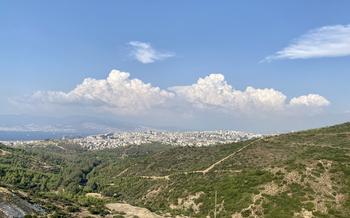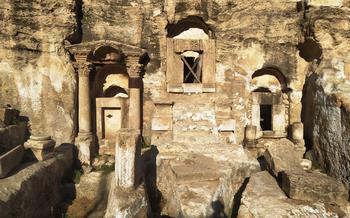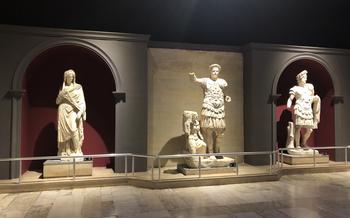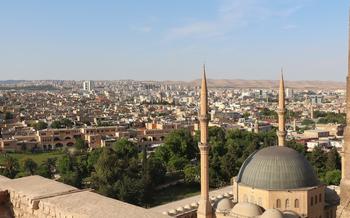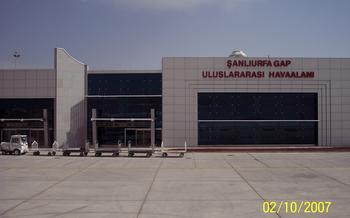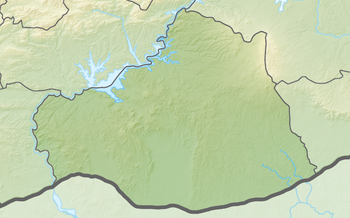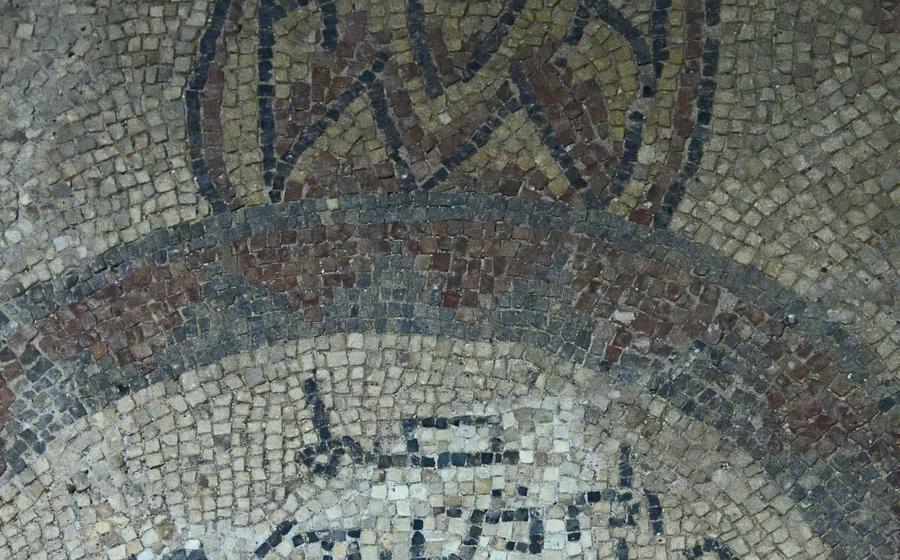
Haleplibahçe Mosaic Museum
- A Journey Through Time: Haleplibahçe Mosaic Museum
- Unveiling the Ancient City of Edessa:
- A Masterpiece of Byzantine Art
- The Hunt Mosaic: A Showcase of Skill
- The Orpheus Mosaic: A Tale of Myth and Music
- The Philosophers' Mosaic: A Tribute to Ancient Wisdom
- The Muses Mosaic: A Celebration of Artistic Inspiration
- The Achilles Mosaic: A Symbol of Strength and Courage
- The Four Seasons Mosaic: A Tribute to Nature's Cycle
- The Animals Mosaic: A Showcase of Biodiversity
- The Geometric Mosaic: A Study in Symmetry and Precision
- The Floral Mosaic: A Celebration of Nature's Beauty
- The People of Edessa Mosaic: A Window into Daily Life
- Insider Tip: Plan Your Visit Wisely
A Journey Through Time: Haleplibahçe Mosaic Museum
The Hal Şanlıurfa, a city once known as Edessa. Its foundation can be traced back to the early 1990s when archaeologists unearthed a stunning collection of mosaics during excavations of an ancient villa in the Haleplibahçe neighborhood. These remarkable artworks, dating back to the 4th and 5th centuries AD, offer a glimpse into the artistry and lifestyle of the ancient city of Edessa.
Situated in the heart of Şanlıurfa, the museum is easily accessible by foot or public transportation. Its unassuming exterior belies the treasures that await visitors within. The building itself is a work of art, designed to complement the historical significance of the mosaics it houses. Its modern architecture blends seamlessly with the surrounding ancient ruins, creating a harmonious dialogue between the past and present.
Unveiling the Ancient City of Edessa:
The Haleplibahçe Mosaic Museum stands as a testament to the rich history of Edessa, an ancient city that once flourished in the region. Edessa, known as Urfa in modern times, served as the capital of the Kingdom of Osroene and played a significant role in the development of Christianity in the Middle East. The city's strategic location at the crossroads of trade routes made it a hub of cultural exchange, attracting diverse influences from the Hellenistic, Roman, and Persian worlds.
Archaeological excavations conducted at the site of the Haleplibahçe Mosaic Museum have uncovered the remains of a large and opulent Roman villa, believed to have belonged to a wealthy and influential family. The villa's elaborate mosaic floors, depicting scenes from mythology, daily life, and religious iconography, provide valuable insights into the culture, beliefs, and artistic traditions of ancient Edessa.
These mosaics not only showcase the exceptional craftsmanship of the artisans who created them but also serve as a window into the daily lives and customs of the city's inhabitants. They depict hunting scenes, religious rituals, philosophical discussions, and even scenes from everyday life, offering a glimpse into the social and cultural fabric of ancient Edessa.
A Masterpiece of Byzantine Art
The mosaics of the Haleplibahçe Mosaic Museum are a testament to the artistic prowess of the Byzantine Empire. Their intricate designs, vibrant colors, and profound symbolism showcase the mastery of the mosaicists who created them. The artistic style of the mosaics is distinctively Byzantine, characterized by its flat, two-dimensional perspective, elongated figures, and symbolic representation of religious and mythological scenes.
The symbolism and iconography of the mosaics are deeply rooted in Christian theology and tradition. The scenes depicted in the mosaics often illustrate biblical stories, such as the Annunciation, the Nativity, and the Crucifixion. The figures are often depicted with symbolic attributes, such as halos, scrolls, and specific gestures, which convey their religious significance.
The mosaics also feature representations of biblical figures, including Jesus Christ, the Virgin Mary, and the apostles. These figures are portrayed with a sense of reverence and awe, reflecting the deep devotion of the Byzantine Christians who commissioned and created these works of art. The mosaics of the Haleplibahçe Mosaic Museum stand as a testament to the enduring legacy of Byzantine art and its profound influence on the cultural and religious heritage of the region.
The Hunt Mosaic: A Showcase of Skill
In the heart of the Haleplibahçe Mosaic Museum, a breathtaking masterpiece unfolds—the Hunt Mosaic. This intricate artwork transports visitors to a vibrant hunting scene, where skilled hunters on horseback pursue their prey amidst a verdant landscape. The mosaic's intricate details and masterful execution showcase the exceptional craftsmanship of ancient artisans.
The Hunt Mosaic is not merely a depiction of a hunting expedition; it holds profound symbolic meanings that reflect the beliefs and traditions of the ancient people of Edessa. Animals, often imbued with symbolic significance, play a crucial role in this mosaic. The lion, representing strength and courage, is a prominent figure, while the deer and other animals symbolize the abundance and diversity of wildlife in the region.
The techniques employed in creating the Hunt Mosaic are a testament to the artistry and skill of ancient mosaicists. The use of tesserae, small pieces of colored stone or glass, allowed for the creation of intricate patterns and realistic representations. The careful arrangement of these tesserae, each contributing to the overall composition, reveals the remarkable patience and precision of the artisans.
The Hunt Mosaic offers a glimpse into the historical context of hunting in the region. Hunting was an essential activity for the survival of ancient communities, providing sustenance and materials for clothing and tools. The mosaic's depiction of the hunt, therefore, holds cultural and historical significance, shedding light on the daily lives and practices of the people of Edessa.
The Orpheus Mosaic: A Tale of Myth and Music
The Orpheus Mosaic, a captivating artwork from the Haleplibahçe Museum, transports visitors to the realm of ancient Greek mythology and pays homage to the enchanting tale of Orpheus, a legendary musician renowned for his unparalleled musical prowess. The mosaic portrays Orpheus as a central figure, seated amidst a serene landscape of flourishing trees and vibrant flora, captivating his audience with the melodious strains of his lyre. His music, imbued with divine power, captivates not only humans but also the wild animals that gather around him, mesmerized by the enchanting melodies.
Orpheus, in Greek mythology, is revered as the son of the muse Calliope and the Thracian king Oeagrus. His extraordinary musical abilities, a gift bestowed upon him by Apollo, the god of music, enabled him to charm all living beings with his enchanting melodies. The mosaic captures one such moment, where Orpheus's music has a profound effect on the surrounding animals, symbolizing the power of music to transcend boundaries and bridge the gap between humans and the natural world.
The Orpheus Mosaic stands as a testament to the significance of music in ancient Greek culture, where it played an integral role in religious ceremonies, festivals, and social gatherings. Music was believed to possess divine qualities, capable of influencing emotions, healing wounds, and even appeasing the gods. The mosaic serves as a reminder of the enduring legacy of Greek mythology and its profound impact on the arts and culture of the ancient world.
The Philosophers' Mosaic: A Tribute to Ancient Wisdom
Among the stunning mosaics of the Haleplibahçe Museum, the Philosophers' Mosaic stands out as a testament to the intellectual pursuits of the ancient Greeks. Depicting seven renowned philosophers, this mosaic offers a glimpse into the world of wisdom and knowledge that flourished in ancient Edessa.
The philosophers are portrayed in a seated position, surrounded by scrolls and other attributes that symbolize their teachings. Each philosopher is easily identifiable by their distinct features and attributes: Socrates with his bald head and long beard, Plato with his scroll and thoughtful expression, Aristotle with his furrowed brow and intense gaze.
The mosaic not only captures the physical likenesses of these great thinkers but also conveys the depth and diversity of their philosophical schools. The Stoics, Epicureans, Platonists, and Aristotelians are all represented, each with their unique perspectives on life, ethics, and the nature of reality.
By studying the Philosophers' Mosaic, visitors can gain a deeper understanding of the intellectual landscape of ancient Greece and the profound impact these philosophers had on Western thought. It serves as a reminder of the enduring legacy of ancient wisdom and the timeless pursuit of knowledge.
The Muses Mosaic: A Celebration of Artistic Inspiration
Amidst the splendor of the Haleplibahçe Mosaic Museum, the Muses Mosaic stands as a testament to the ancient Greeks' profound appreciation for the arts. This awe-inspiring artwork depicts the nine Muses, divine beings who personified the various forms of artistic expression. Each Muse is portrayed with her distinct attributes, symbolizing their respective domains.
Euterpe, the Muse of music, holds a double flute, while Melpomene, the Muse of tragedy, is adorned with a tragic mask. Thalia, the Muse of comedy, wears a comic mask, and Clio, the Muse of history, is accompanied by a scroll, representing the recording of past events. Erato, the Muse of love poetry, is depicted with a lyre, and Polyhymnia, the Muse of sacred poetry, holds a scroll, symbolizing the written word. Terpsichore, the Muse of dance, is shown in a graceful pose, while Urania, the Muse of astronomy, gazes up at the heavens, her celestial realm. And finally, Calliope, the Muse of epic poetry, is portrayed with a wax tablet and stylus, tools used for writing.
The Muses Mosaic is not merely a beautiful work of art; it is a profound symbol of the importance of artistic inspiration and creativity in ancient Greek culture. These divine beings were believed to be the source of all artistic endeavors, and their presence in the mosaic serves as a reminder of the enduring power of the arts to inspire and uplift the human spirit.
The Achilles Mosaic: A Symbol of Strength and Courage
Amidst the splendor of the Haleplibahçe Mosaic Museum, the Achilles Mosaic stands out as a testament to the legendary hero of Greek mythology. This intricate artwork portrays Achilles, the invincible warrior known for his strength, courage, and determination. The mosaic depicts Achilles in the midst of the Trojan War, locked in a fierce battle against his enemies. His powerful stance and unwavering gaze convey the essence of his indomitable spirit. The vibrant colors and intricate details of the mosaic bring Achilles to life, inviting visitors to step into the realm of ancient myths and legends.
The symbolism of the Achilles Mosaic extends beyond its depiction of the hero himself. It represents the broader themes of the Trojan War, a conflict that shook the foundations of the ancient world. Achilles' role as a pivotal figure in this epic struggle underscores the significance of strength, honor, and the indomitable human spirit. This mosaic serves as a reminder of the enduring legacy of Greek mythology and its influence on Western culture.
Through this captivating artwork, visitors to the Haleplibahçe Mosaic Museum are transported back in time to witness the legendary exploits of Achilles. The mosaic not only portrays a powerful warrior but also embodies the timeless ideals of heroism, courage, and unwavering determination. It is a masterpiece that continues to captivate and inspire, leaving an indelible mark on the minds of those who behold it.
The Four Seasons Mosaic: A Tribute to Nature's Cycle
The Four Seasons Mosaic is a stunning representation of the cyclical nature of time and the changing seasons. It depicts four personifications of the seasons, each accompanied by symbols and attributes that represent their unique characteristics. Spring is portrayed as a young woman adorned with flowers and holding a basket of fruits, symbolizing new life and growth. Summer is depicted as a muscular man carrying a sickle, representing the time of harvest and abundance. Autumn is personified as a woman holding a cornucopia overflowing with grapes, symbolizing the richness of the harvest season. Winter is portrayed as an old man wrapped in a cloak, signifying the cold and dormant period of the year.
The mosaic's vibrant colors and intricate details bring the seasons to life, capturing the essence of each one through allegorical imagery. It serves as a reminder of the cyclical nature of time, the beauty of nature's changing seasons, and the importance of appreciating the diversity and bounty of each season.
The Animals Mosaic: A Showcase of Biodiversity
The Animals Mosaic is a stunning display of the rich and diverse wildlife that once roamed the lands of ancient Edessa. With intricate detail and vibrant colors, this mosaic depicts a wide variety of creatures, both real and mythical. Lions, tigers, elephants, and leopards are among the recognizable animals depicted, while mythical creatures such as griffins and centaurs add a touch of fantasy to the scene.
The symbolism and representation of animals in ancient art are deeply rooted in mythology and folklore. Lions, for example, were often associated with strength and courage, while elephants represented wisdom and intelligence. Mythical creatures like griffins, with their lion-like bodies and eagle-like heads, symbolized power and protection.
The techniques used to create the Animals Mosaic are a testament to the skill and artistry of ancient mosaic makers. Small, colored tiles, known as tesserae, were carefully arranged to form the intricate patterns and shapes of the animals. The use of shading and highlights creates a sense of depth and realism, bringing the creatures to life.
The historical context of animal depictions in the region is closely tied to the beliefs and practices of the ancient people who inhabited this land. Animals were not only a source of food and companionship but also held significant religious and symbolic meanings. The Animals Mosaic offers a glimpse into the minds and imaginations of these ancient people, providing valuable insights into their culture and worldview.
The Geometric Mosaic: A Study in Symmetry and Precision
Amidst the intricate narratives and vibrant figures of the Haleplibahçe mosaics, the geometric compositions stand out with their stark simplicity and elegant precision. These mosaics, devoid of any representational elements, showcase the mastery of ancient artisans in creating visually stunning patterns using basic geometric shapes.
The geometric mosaics often feature repeating patterns of squares, triangles, circles, and hexagons, arranged in symmetrical configurations that create a sense of order and harmony. The harmonious interplay of these shapes and the subtle variations in color create a mesmerizing effect that draws the viewer's eye and invites contemplation.
The geometric mosaics served several purposes. They were used to decorate floors, walls, and other architectural elements, adding a touch of sophistication and elegance to the spaces they adorned. Additionally, these mosaics may have had symbolic meanings, representing concepts such as infinity, balance, and the interconnectedness of all things.
The geometric mosaics in the Haleplibahçe Museum are a testament to the skill and creativity of ancient artisans. They demonstrate a deep understanding of geometry and a keen eye for detail, creating works of art that continue to captivate and inspire viewers centuries after their creation.
The Floral Mosaic: A Celebration of Nature's Beauty
Among the stunning mosaics in the Haleplibahçe Mosaic Museum, the Floral Mosaic stands out with its vibrant depiction of nature's beauty. This intricate mosaic features a dazzling array of flowers and plants, each rendered with remarkable detail and precision. The colors are so vivid that they seem to leap off the floor, creating a sense of immersion for the viewer.
Roses, lilies, poppies, and daisies bloom in abundance, their petals delicately crafted to capture their unique shapes and textures. Vines and leaves intertwine, forming intricate patterns that enhance the overall composition. The mosaicist's skillful use of shading and perspective creates a sense of depth and realism, making the flowers appear almost lifelike.
The Floral Mosaic is not merely a decorative piece; it also holds symbolic significance. Flowers have long been associated with various meanings in different cultures. In ancient times, they were often used to represent love, beauty, fertility, and renewal. The inclusion of flowers in this mosaic suggests that the ancient inhabitants of Edessa shared these sentiments and held nature in high regard.
The techniques used to create the Floral Mosaic are equally impressive. The tesserae, or small tiles that make up the mosaic, are tiny and irregularly shaped, allowing for a smooth and seamless transition between colors. The artist's careful placement of each tessera creates a harmonious balance between the individual elements and the overall design.
The Floral Mosaic is a testament to the skill and artistry of the ancient mosaicists of Edessa. It offers a glimpse into their appreciation for nature and their ability to capture its beauty in a lasting form. This mosaic serves as a reminder of the enduring power of art to celebrate the wonders of the natural world.
The People of Edessa Mosaic: A Window into Daily Life
Amidst the grandeur of the Haleplibahçe Mosaic Museum, one mosaic stands out for its unique portrayal of everyday life in ancient Edessa: the People of Edessa Mosaic. This intricate artwork offers a rare glimpse into the daily routines, customs, and social interactions of the city's inhabitants.
Crafted with meticulous attention to detail, the mosaic depicts a bustling marketplace, complete with merchants, shoppers, and animals. Each figure is engaged in their own activity, from buying and selling goods to tending to livestock. The mosaic also features scenes of people engaged in leisure activities, such as playing music or attending social gatherings.
The People of Edessa Mosaic is not only a stunning work of art but also a valuable historical document. It provides insights into the economic, social, and cultural aspects of life in ancient Edessa. The mosaic showcases the city's diverse population, including merchants, artisans, farmers, and musicians. It also highlights the importance of trade and commerce in the region, as well as the vibrant social life that characterized the city.
By studying this mosaic, visitors can gain a deeper understanding of the daily lives of the people who lived in Edessa centuries ago. It offers a glimpse into their world, their customs, and their interactions with one another, providing a tangible connection to the past and a deeper appreciation for the rich history of this ancient city.
Insider Tip: Plan Your Visit Wisely
Timing your visit to the Haleplibahçe Mosaic Museum is crucial to ensure a fulfilling and enjoyable experience. The museum welcomes visitors throughout the week, but it's advisable to avoid weekends and public holidays to steer clear of crowds. The tranquility of a weekday morning provides the perfect atmosphere to immerse yourself in the museum's treasures.
Take advantage of the guided tours offered by the museum, as they provide insightful commentary and explanations that enhance your understanding of the mosaics and their significance. Audio guides are also available for a self-guided exploration at your own pace.
When capturing the beauty of the mosaics through photography, ensure that you respect the museum's guidelines and avoid using flash, as it can damage the delicate artworks. Share your experiences on social media using the appropriate hashtags to connect with other art enthusiasts and spread the word about this hidden gem.
To make the most of your trip, combine your visit to the Haleplibahçe Mosaic Museum with other attractions in Şanlıurfa. The city boasts a rich history and culture, with sites like the Göbekli Tepe, the Şanlıurfa Castle, and the Şanlıurfa Museum waiting to be discovered. Plan a comprehensive itinerary to delve into the diverse offerings of this captivating city.
